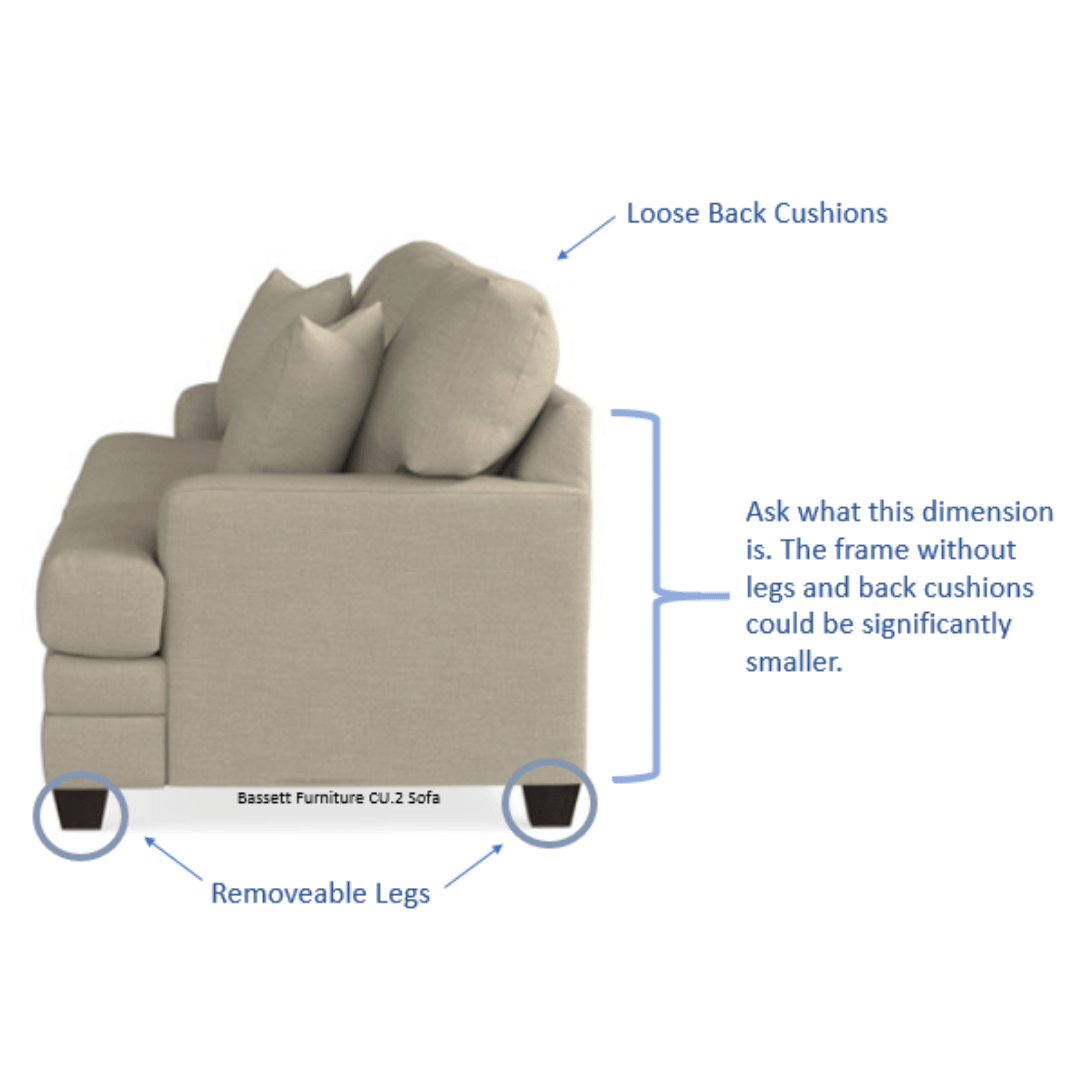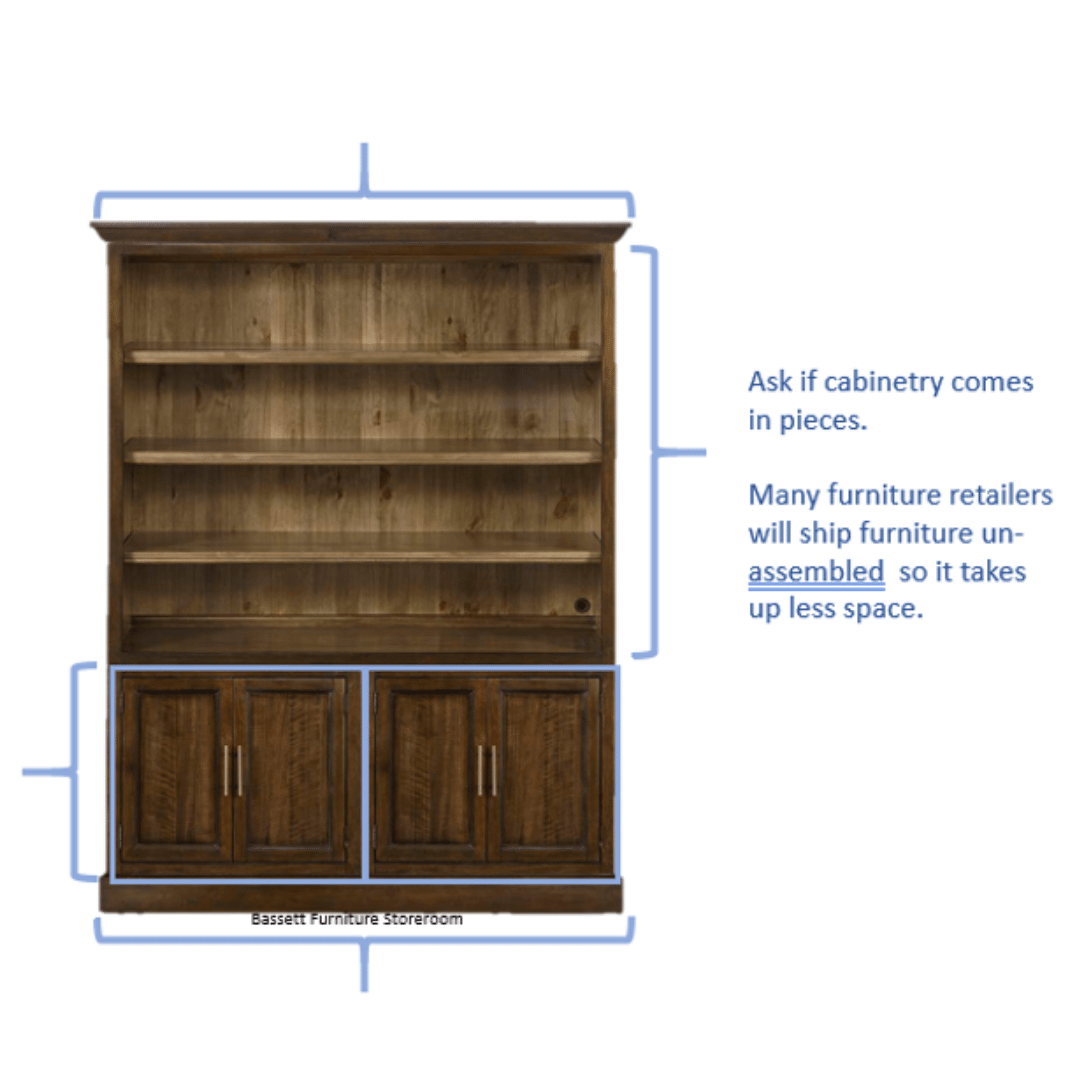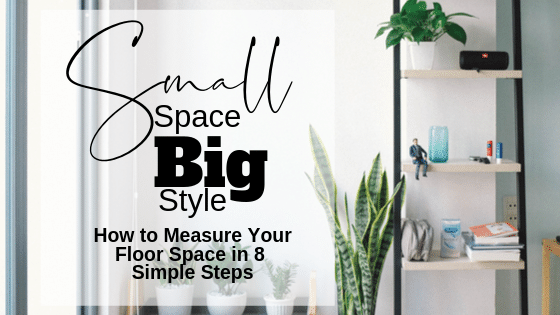Sometimes it’s not the size of the room that can stop a redecorating project, it’s the path to get into the space. I love small houses! In my opinion, they’re efficient and clean up fast, which makes them easy to keep tidy. They also often have narrow hallways and sharp turns making moving furniture a real task. Many older homes have the enclosed, steep stairways going up or down. Sometimes the stairs to the basement have a turn or are positioned underneath the stairs to the second floor. That usually means a stepped ceiling where things can get easily wedged. I’ve been in countless homes where the front entry has a built-in closet or sharp turn right inside the door. That’s a tight squeeze for long furniture like sofas and dressers. There can be a lot of obstructions that make getting furniture in tough.
There is literally nothing more frustrating than getting a huge sofa jammed into a narrow stairway when you’re tired from a move or in the final stretch to getting your project done. Before you make impulsive decisions on your next XL sofa purchase, here’s a few very important questions to ask when buying furniture for your small home.
Question 1: Do the Legs Come Off?
Some sofas have solid frames where the front and back legs are part of the frame system. This means the legs don’t come off. Other sofas have back legs attached to the frame and removable front legs. This can sometimes give you enough clearance to maneuver the frame around and through exterior and interior doorways. Then there are options that have all removable legs which gives you the best opportunity to fit the sofa through small doorways. This brings me to question two:
Question 2: What is the Size of the Frame Without the Legs Attached?
This question can make all the difference in tight spaces. If the legs come off, that usually means the frame is shallow enough to make it through smaller doors or enclosed staircases. If the back cushions are loose, this will make it even easier to get it through a narrow doorway. Attached back cushions can be compressed with a bit of plastic wrap but care but don’t try to jam it through doorways because you could tear the upholstery. Just like cutting wood for a project, measure twice buy once. This means know the size of all the pathways against the dimensions of the furniture. Again, measuring those spaces will make this job so much easier.
Question 3: Does the Furniture Come in Sections?
This is a great option for both upholstered furniture as well as cabinetry and display pieces. If you know that you can get a sofa as a sectional and you know that the sofa, being one solid piece, won’t fit down the enclosed basement stairs to the media room, then consider the sectional version.
The sections will usually make the same overall dimensions as the sofa but it will be easy to move individual pieces into a tricky space much easier than trying to move a solid piece. You will end up with a few more legs showing but that is a small consolation for being able to have a comfortable piece where you want it.
If you’re buying accent furniture or display cabinets, ask if the furniture company if the furniture comes in KD or knock down. This is simply a code for unassembled It’s easier to transport some furniture in boxes rather than transporting fully assembled pieces. Assembled furniture takes up more space and could be potentially damaged in the transporting process. This is usually the case for accent furniture like side tables and some upholstered chairs but, larger furniture like wall units or media display will often come in knock down boxes. It’s easier to put a box or a few boxes in your vehicle rather than a fully assembled piece. You could make a couple of trips to pick things up if needed too.
Question 4: Ask the Furniture Store, Will Someone Come to Measure?
Many custom furniture stores have a complimentary design service and the very first thing an in-store designer will do is measure the space to make sure the furniture will fit. This ensures that they won’t have to contend with a “no fit” when the furniture is delivered and it gives you the peace of mind that your furniture will fit in the space and through all the paths it needs to travel to get there.
Question 5: Do You Deliver?
Sometimes the cost of delivery well outweighs the frustration of trying to maneuver your furniture into tight spaces. Delivery teams are professionals who have seen it all. They know how to negotiate tight turns or how to tilt and pivot furniture to get the job done. They also know what pieces are removable so they can get the furniture in position without damaging walls or the furniture.
Many times, the cost of delivery comes with the added benefit of one year of service and the peace of mind that if you have an issue with the furniture, you will be able to have it repaired at no additional cost to you. Store delivery teams, for the most part, are insured and any mishap to the furniture or your property can be repaired because of the insurance. It you damage your furniture or home moving the new piece yourself, you’ll probably be out the price to repair the house and the furniture as well. That will most definitely cost you more than the price of delivery.
The larger online retailers often have an assembly option when you purchase your furniture. In this example, if you purchase your furniture online you can add on the assembly service, so you don’t have to tackle the job yourself. When your furniture arrives, a person comes to assemble it for you. You get your furniture delivered AND put together. This is a no brainer, if you ask me!
Measure: Doorways, Enclosed Staircases: Including Ceiling Height and Turns, Elevators and Hallways
If you’ve been reading my weekly posts, you’ll know that accurately measuring your space is my battle cry. It literally curtails a slew of problems from happening. The very first problem it solves is disappointment. You can orchestrate the best plan for transporting the furniture, have the best team of friends and relatives to get it home, only to learn that your new sofa can’t make the turn inside the front door or that it just won’t fit in at all. It’s worth the extra couple of minutes to know exactly what the clearance is with the door on and off the hinges.
Conclusion:
Getting furniture into tight spaces should never be a guessing game. If you have a small entryway or challenging path through the house, always ask:
Do the Legs Come Off?
What is the Size of the Frame Without the Legs Attached?
Does the Furniture Come in Sections?
Will Someone Come to Measure?
Do You Deliver?
If you need a little extra help knowing how to measure your space, including doorways, I’ve got you covered! Small Space Big Style, How to Measure Your Space in 8 Simple Steps. It’s my FREE short, value packed, guide to the most important first step in any makeover project: knowing exactly how much space you have. It will also show you how to measure doorways and what to think about for getting furniture through all the entryways you have.
It’s a small file, short and sweet and it can be downloaded right to your phone or tablet so it’s in your hand right when you need it. Click the link and sign up below. When you sign up, you’ll get your instant download of Small Space Big Style and I’ll send you an email every Friday at 1 PM with a link to my latest blog. Don’t worry, I promise not to spam you with promotions. I am way more excited to serve you! I’ll share all my pro tips for designing and decorating small spaces so, you never have to worry about missing another post again!
Thank you so much for spending a few minutes with me this week! I appreciate your time and I hope you go a tip or two for moving furniture into your small space. If you liked this post, make sure you click the heart below to give it some love and if you think a friend could use this advice, please share it with them by clicking on any of the share buttons on this page. Until next week my friend, stay amazing and keep your dreams big for your small space!
P.S. Let me know in the comments below if you have experienced difficulties moving large pieces into tricky or small spaces. How did you finally get the furniture in? Did you have to take doors off hinges or modify the furniture in some way? What would you do differently the next time you need to move stuff?
Michael is Principal designer and blogger at Michael Helwig Interiors in beautiful Buffalo, New York. Since 2011, he’s a space planning expert, offering online interior e-design services for folks living in small homes, or for those with awkward and tricky layouts. He’s a frequent expert contributor to many National media publications and news outlets on topics related to decorating, interior design, diy projects, and more. Michael happily shares his experience to help folks avoid expensive mistakes and decorating disappointments. You can follow him on Pinterest, Instagram and Facebook @interiorsmh.












